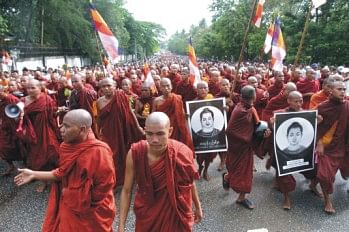Burmese monks' protest marches now openly challenge rulers

Buddhist monks march in protest in Yangon, September 24, in the strongest show of dissent in nearly two decades.Photo: AFP
Nearly twenty years after mass pro-democracy demonstrations forced the former dictator General Ne Win to resign, thousands of people have been taking to the streets again to protest against the country's military rulers. In the past two days more than 10,000 people have joined the biggest protest marches in the former capital Rangoon since 1988.
Powerless to stop them, Burma's military authorities are increasingly worried that they are losing control of the country as monks, students and ordinary people are courageously joining the street protests against the military government.
Throughout Burma thousands of Buddhist monks have led these protest marches in what is fast becoming a saffron revolt -- because of the colour of the monks' robes -- to their vent anger at the military government's disregard for the plight of the people.
For more than a week now the revered monks have marched in protest against the country's military rulers. These protests are snowballing and are now seriously threatening the generals' grasp on power. From a few hundred monks, these demonstrations have grown dramatically to more than a hundred thousand.
"We may have reached the tipping point," independent Burmese analyst, Win Min, based at Chiang Mai University told this correspondent. "The movement is growing, and it's developing a momentum all of its own."
The regime is so worried that they have ordered all monks back to their monasteries and off the streets. It is not clear whether the monks will obey these instructions.
After a meeting with Buddhist religious leaders on Monday, the Minster for Religion Thura Myint Maung warned young monks and novices not to break Buddhist "rules and regulations" in a televised interview on the state-run television. The monks were that if they continued their protests they would face legal action.
The country's top generals have discussed the current unrest in an emergency meeting in the new capital Naypitdaw. So far the military are only threatening to come down hard on the monks. But there are growing fears that the generals may be about to move against the monks. More than 3,000 people died when the military took action against the massive pro-democracy movement some twenty years ago.
Every day the marches get bigger and bigger involving monks in more and more towns and cities across the country. On Monday more than a hundred thousand people marched, by thousand of barefooted monks, to the renowned Shwedagon pagoda in central Rangoon.
More than 20,000 people marched through Rangoon on Sunday. The day before at least 10,000 monks reportedly marched along the road in single file in the Buddhist heartland in central Burma around Mandalay. Buddhist nuns have also joined the demonstrations in the last few days. On Monday there were reportedly monk-led marches in more than thirty cities and towns across the country, including Mandalay, Moulmein, Pegu, Mytikyina near the Chinese border and Sittwe in the west of the country.
These protests are set to grow. "We want the people to join us," the monks chanted as they walked though Rangoon on the weekend. And on Monday thousands heeded their call and joined the march.
This public defiance is the first serious show of anti-government feeling for more than 19 years. More marches are planned for later this week, according to a senior Buddhist monk who did not want to be identified. The monks of Rangoon have continued to call on ordinary people to support the protests. They have also asked the students to join the major protest rally planned for today -- the next Buddhist Sabbath.
This protest march is expected to be the bigger so far and could match the huge crowds that came out onto the streets nearly twenty years ago and helped topple the ruling dictator General Ne Win.
The last few days have also marked a turning point in the monks' movement for justice. Up until a few days ago the monks had been primarily protesting against the local authorities' use of violence to quell an earlier march near Mandalay, where several monks were badly beaten by violent vigilantes wielding sticks.
All along though the monks have also been calling on the government to reduce prices, supporting the first of the public protests that broke out more than a month ago after the government raised fuel charges by up to 500 percent.
The monks are motivated by their concern for the deteriorating condition in which most people have to live. The monks are close to the people and understand their hardships. "They know better than anyone, the impact the rising fuel and food prices is having on the people at the grassroots," sys the Burmese analyst, Aung Naing Oo, who himself lived in a monastery for sometime.
Monks rely on collecting daily alms from the public for their survival. They understand that this has become harder and harder, especially over the last two years. "What they used to get from four or five houses, now takes more than thirty," says Aung Naing Oo.
The increasing economic hardship has also boosted the population of monks and novices in the monasteries. There has also been a dramatic increase the number students from poor families.
But now the monks' marches have clearly turned political. "We want national reconciliation, we want dialogue with the military, we want freedom for Aung San Sun Kyi and other political prisoners," a protest leader shouted through a microphone during Sunday's protests in Rangoon.
More importantly the monks are also calling for dialogue and national reconciliation with all parties -- another way of advocating the start of genuine political talks between the military and the pro-democracy parties, particularly the National League for Democracy, led by Aung San Suu Kyi who is currently under house arrest in Rangoon. She has spent more than 12 of the last 18 years in detention. In a very import symbolic act, more than 2,000 monks marched to her home on Saturday and she came out to pay her respect to them.
Burma's monks do not see themselves as political. They usually only come out of their monasteries to defend the Sangha -- their faith and their elders -- and to support the people on social and economic issues. "Normally monks are not political," said Win Min. "They focus on their individual enlightenment according to traditional Buddhism. What is happening now shows that the situation has reached the point where they can no longer tolerate it."
In the coming days and weeks much will depend on how the military decides to handle the demonstrations. So far, apart from a couple of nasty incidents earlier, the authorities have been relatively restrained and not interfered with the marching monks.
But there were hints on Sunday that the government may been considering more dramatic action against the protestors in future, when they prevented the monks from visiting Aung San Suu Kyi on the second successive day by using water cannons fired from fire-engines.
It remains unclear though how they will react when the demonstrations grow and involve students and ordinary citizens.
"The military will find it hard to suppress the monks' movement as monks are sacred symbols in this Buddhist society. They will draw wide public support, as monks have a great influence over the people, that could lead to significant change," according to Win Min.
The next few days will be crucial as students and ordinary people join the demonstrations which have clearly turned political and directly challenging the military. A group calling itself the All Burma Monks Alliance, which represents the younger more radical Buddhist clergy recently urged ordinary people "to banish struggle peacefully against the evil military dictatorship" until its downfall.
"We pronounce the evil military despotism, which is impoverishing and pauperizing our people of all walks including the clergy, as the 'common enemy' of all our citizens," the alliance said in a statement emailed to this correspondent.
The monks are discussing joint action with former student leaders from the 1988 protests in secret, according to sources close to the 88 generation group. The monks have asked the students to unfurl the fighting peacock flag -- the students' symbol which dominated the 1988 protests -- at future demonstrations. The military will see this as a very provocative act, but the monks have promised to protect the students.
"We are going for it, this is our time. We have to take this chance now as there may never be another one," a senior former student leader told this correspondent from hiding inside the country. "The students will support the monks' peaceful protests," he said.
The monks and the students are clearly concerned that the movement remains peaceful. "The monks are the country's moral authority and Aung San Suu Kyi has the political authority -- both are promoting peaceful change," according to a prominent Burmese activist based in Thailand, Soe Aung.
The monks' visit to Aung San Suu Kyi's home over the weekend reflects the new political nature of the protests. A very devout Buddhist, she has always promoted change through non-violent means.
"The monks and the students are beginning to join forces in what will be a potent force for change," a western diplomat based in Rangoon told this correspondent. "Unless the military are prepared to shoot the monks, which is highly unlikely because of their revered position in Burmese society, the government may have no other option but to concede to the demonstrators' demands and at least start a dialogue with the opposition," he added.
Larry Jagan is a former Current Affairs Editor, Asia, BBC World Service.

 For all latest news, follow The Daily Star's Google News channel.
For all latest news, follow The Daily Star's Google News channel. 



Comments